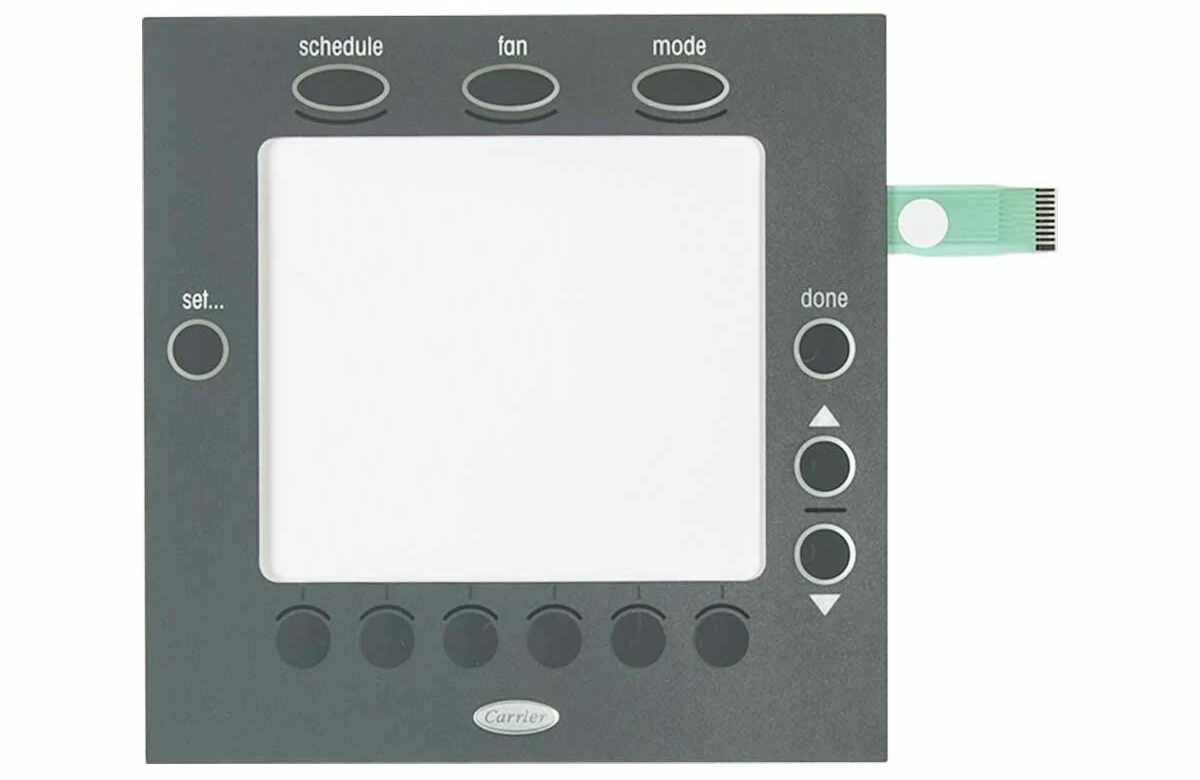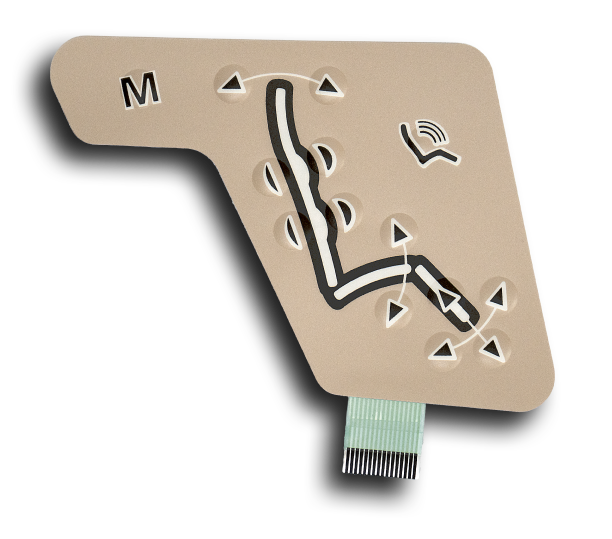Membrane Switch Manufacturer Offering Precision Engineering Solutions
Membrane Switch Manufacturer Offering Precision Engineering Solutions
Blog Article
Exploring the Manufacturing Refine of Membrane Switch for Numerous Industries
The production process of Membrane buttons is a complex undertaking that requires accuracy and focus to detail. From selecting suitable materials to executing strenuous quality assurance measures, each step plays a vital duty in making certain performance. Different markets, consisting of automobile and medical, depend on these components for their distinct applications. Understanding the complexities of this process exposes considerable understandings right into how these buttons are created and their influence across varied sectors.
Comprehending Membrane Switches Over: A Review

Trick Materials Used in Membrane Switch Production
In Membrane button manufacturing, the option of essential products substantially affects capability and durability. Conductive materials, adhesives, and coverings play important roles, while substrate choice affects overall performance and reliability. Recognizing these elements is essential for optimizing the design and production of Membrane buttons.
Conductive Materials Review
Conductive products play a crucial role in the performance of Membrane buttons, making certain trusted electrical connections within the gadget. Generally made use of materials include silver, copper, and carbon-based inks, each offering distinctive benefits. Silver is preferred for its high conductivity and longevity, making it ideal for applications needing durable efficiency. Copper, while slightly much less conductive than silver, is an economical option frequently made use of in printed circuits. Carbon-based inks offer a flexible alternative, suitable for applications where adaptability and lower costs are prioritized, although they have lower conductivity compared to metal options. The choice of conductive products straight impacts the overall dependability, life-span, and performance of the Membrane switch, making it an essential consideration in the manufacturing process.
Adhesives and Coatings
Adhesives and coverings are necessary parts in the manufacturing of Membrane buttons, supplying crucial bonding and safety residential or commercial properties. These materials guarantee that various layers of the button, including graphic overlays and circuitry, stick safely to each other, enhancing sturdiness and performance. Commonly utilized adhesives consist of pressure-sensitive adhesives (PSAs) and epoxy-based formulas, which offer solid adhesion and strength. Coatings, such as polyurethane or acrylic, offer to secure against ecological factors, including moisture, abrasion, and chemicals. Furthermore, coverings can boost responsive comments and aesthetic allure, adding to the total customer experience. The option of suitable adhesives and coatings is critical for maximizing efficiency and durability in diverse applications throughout different sectors, making certain that Membrane changes satisfy details functional needs.
Substratum Option Aspects
Substratum option plays a vital duty in the manufacturing of Membrane switches, as it substantially affects their general efficiency and toughness. Trick materials such as polyester, polycarbonate, and versatile printed circuit boards (FPCBs) are typically made use of for their distinctive properties. Polyester is favored for its cost-effectiveness and resistance to abrasion, making it ideal for applications with high wear. Polycarbonate offers remarkable clearness and influence resistance, suitable for atmospheres calling for high presence. FPCBs offer boosted adaptability and are commonly used in complicated designs. The option of substratum also influences elements like thermal stability, chemical resistance, and simplicity of printing. Ultimately, choosing the proper substrate is vital for ensuring the performance and longevity of Membrane switches over throughout different industries.
The Style Refine of Membrane Switches Over
The style procedure of Membrane switches is a vital stage that significantly influences the functionality and appearances of the end product - membrane switch manufacturer. It begins with specifying the details requirements of the application, consisting of measurements, switch design, and tactile responses choices. Developers should consider customer communication, ensuring that the switch is intuitive and accessible.Next, products are picked based on sturdiness, versatility, and ecological resistance. The assimilation of graphics and branding aspects is likewise vital, as it enhances aesthetic charm and communication. Prototyping enables for repetitive screening, enabling changes based upon customer responses and performance evaluations.Additionally, the design should make up the electrical parts, such as adapters and circuits, guaranteeing reliability and convenience of use. Ultimately, a successful layout balances performance, aesthetic appeals, and customer experience, leading the way for efficient manufacturing and long-lasting performance in numerous sectors
Printing Strategies for Membrane Switches Over
The printing methods made use of in Membrane button manufacturing play a necessary function in identifying the end product's high quality and performance. Screen printing offers advantages such as durability and dynamic shade application, while electronic printing technologies give flexibility and precision in style. Comprehending these techniques can substantially influence the overall effectiveness of Membrane switches in different applications.
Screen Printing Benefits
Numerous benefits make display printing a favored method for producing Membrane switches. This approach enables for high-grade, in-depth layouts and dynamic shades, which are vital for interface applications. Display printing is specifically efficient for applying thick ink layers, improving durability and responsive responses. In addition, it provides exceptional adhesion to different substrates, guaranteeing durability popular settings. The process is cost-efficient for huge production runs, as it decreases configuration time and waste. In addition, display printing supports a wide array of inks, consisting of specialized and UV-curable alternatives, making it possible for versatility in layout. Its capacity to produce regular outcomes throughout numerous units makes it a dependable choice for makers aiming for top quality and effectiveness in Membrane button manufacturing.
Digital Printing Innovations

Innovations in digital printing modern technology are changing the manufacturing of Membrane buttons, offering manufacturers ingenious solutions that enhance style versatility and effectiveness. Digital printing allows for high-resolution graphics and detailed styles, allowing customized branding and performance without the restrictions of conventional techniques. This method decreases configuration times and costs, assisting in shorter manufacturing runs and minimal waste, making it optimal for businesses with varying needs. Furthermore, advancements in ink formulations provide much better longevity and bond, making sure durability in numerous atmospheres. As markets increasingly look for customized and complicated layouts, digital printing stands apart as a crucial strategy, establishing a brand-new standard in Membrane button production. The combination of these innovations positions manufacturers to fulfill advancing market needs effectively.
Setting up and Layering of Membrane Switch Parts
Mindful setting up and layering of Membrane switch components are necessary to ensuring performance and longevity. This process starts with the accurate positioning of different layers, consisting of the graphic overlay, adhesive, circuit layer, and backing material. Each component has to be very carefully positioned to maintain electric stability and interface responsiveness.During setting up, conductive traces are related to the circuit layer, commonly made from materials like polyester or polycarbonate. This layer is vital, as it beams when stress is applied. The glue utilized for bonding these layers is also chosen for its capacity to withstand environmental stresses while keeping a safe bond.Heat and stress are frequently applied during the assembly process to ascertain that the layers stick appropriately without jeopardizing the capability of the switch. Finally, interest is provided to the side sealing to protect against moisture and impurities, protecting the durability of the Membrane button in numerous commercial applications.
Quality Control Procedures in Membrane Switch Manufacturing
Quality control steps play an essential role in ensuring the integrity and efficiency of Membrane switches over following the assembly and layering of their components. In the manufacturing procedure, several essential evaluations are performed to promote top quality criteria. These consist of visual inspections for problems in printing and glue application, along with practical tests to confirm the responsiveness of each switch.Additionally, ecological screening is done to analyze the switches' resilience against temperature variations and humidity exposure. Manufacturers typically implement statistical procedure control (copyright) methods to monitor manufacturing uniformity, enabling early discovery of anomalies.Furthermore, traceability systems are established to track products and components, ensuring responsibility and helping with recalls if essential. Calibration of equipment and adherence to sector criteria are also crucial to preserving item honesty. Jointly, these quality assurance actions safeguard the performance of Membrane switches over across various applications, eventually enhancing customer fulfillment.
Applications of Membrane Switches Throughout Different Industries
Membrane buttons are used throughout a varied selection of sectors, showcasing their convenience and versatility. In the clinical sector, they give waterproof and reputable interfaces for tools such as analysis equipment and mixture pumps, making sure health and ease of usage. The vehicle sector utilizes Membrane buttons for control panel controls, making it possible for seamless communication in hop over to here between the chauffeur and car systems.In consumer electronic devices, these switches are discovered in home appliances and portable tools, offering a smooth, contemporary aesthetic while improving performance. Industrial applications also take advantage of Membrane changes for equipment control board, where sturdiness and resistance to rough problems are essential.Furthermore, the aerospace and protection markets make use of Membrane buttons for cabin official source instrumentation and interaction systems, focusing on integrity and efficiency under severe conditions. Overall, Membrane buttons play a crucial role in enhancing the user experience and functional performance across different domain names.
Often Asked Questions
For how long Does It Take to Make a Membrane Layer Switch?
The production time for a membrane switch usually ranges from a couple of days to numerous weeks - membrane switch manufacturer. Aspects influencing this period consist of style complexity, product accessibility, and manufacturing quantity, all impacting the total timeline significantly
What Is the Regular Life-span of a Membrane Switch?
The normal life expectancy of a membrane layer switch typically varies from 1 to 5 million actuations, depending upon variables such as worldly top quality, environmental conditions, and use regularity, greatly influencing resilience and overall performance.
Can Membrane Switches Over Be Customized for Specific Applications?
Membrane switches can certainly be tailored for certain applications. Their design adaptability permits modifications in size, form, shades, and graphics, guaranteeing compatibility with special demands across different sectors and enhancing performance and user experience.

Are Membrane Switches Over Eco-friendly?
The environmental effect of Membrane switches over differs. Some products used might not be environmentally friendly, while innovations in manufacturing processes are progressively concentrating on sustainability, aiming to decrease waste and advertise recyclable components in their production.
What Are the Typical Failing Settings of Membrane Buttons?
Usual failing modes of Membrane buttons consist of delamination, glue failing, damage from usage, wetness ingress, and electrical failures. These concerns can considerably influence capability, efficiency, and life-span in different applications throughout various markets. Membrane buttons can be customized to fit particular style needs, such as dimension, performance, and shape, making them highly adaptable.The construction usually includes multiple layers, consisting of a graphic overlay, adhesive, and a circuit layer, which function with each other to create a seamless customer experience. In Membrane button production, the selection of essential products considerably influences functionality and resilience. The automobile sector utilizes Membrane buttons for dashboard controls, enabling smooth interaction Find Out More between the vehicle driver and lorry systems.In customer electronics, these switches are discovered in devices and handheld tools, using a sleek, modern aesthetic while boosting functionality. Industrial applications additionally utilize Membrane switches for equipment control panels, where sturdiness and resistance to harsh problems are essential.Furthermore, the aerospace and defense sectors use Membrane buttons for cockpit instrumentation and interaction systems, prioritizing dependability and efficiency under extreme problems. Membrane switches can without a doubt be personalized for specific applications.
Report this page